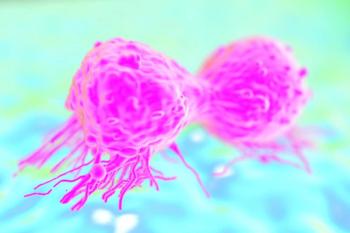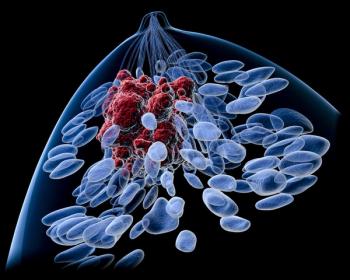
Oncology NEWS International
- Oncology NEWS International Vol 8 No 1
- Volume 8
- Issue 1
Strategies for Managing Breast Cancer During Pregnancy
FLORENCE, Italy-Although as many as 2.8% to 4.5% of all breast cancers occur during pregnancy or lactation, there are scant controlled trial data to help clinicians steer the difficult course between optimizing the outcome for the mother and protecting the child.
FLORENCE, ItalyAlthough as many as 2.8% to 4.5% of all breast cancers occur during pregnancy or lactation, there are scant controlled trial data to help clinicians steer the difficult course between optimizing the outcome for the mother and protecting the child.
A multidisciplinary roundtable, convened at the First European Breast Cancer Conference, reviewed the available data and formulated recommendations for diagnosing and managing breast cancer in pregnant women.
Pregnancy itself is not a contraindi-cation to investigation for breast cancer, said roundtable chairman Dr. S. Parbhoo, a breast surgeon at the Royal Free Hospital, London. Dr. Parbhoo urged obstetricians and general practitioners to be alert to abnormal breast changes during pregnancy, since pregnancy may mask the early signs of breast cancer.
They must listen to the patient who has detected or felt something abnormal or unusual in the breast, he advised. In my opinion, all patients with breast problems while pregnant or lactating should undergo careful assessment and should be referred to a breast specialist.
Since more than half of pregnant women with breast cancer have disease that has spread beyond the breast, Dr. Parbhoo said, surgery plays only a secondary role in this setting. We have to provide tissue for diagnosis, but sometimes it may be difficult to identify the site of the cancer in the swollen breast, he said. He noted that breast-conserving surgery is feasible after primary chemotherapy, although he cautioned that inflammatory cancers may require mastectomy and radiotherapy.
Diagnostic Delays More Common
Special hazards for pregnant women with breast cancer may arise from a delay in diagnosis or from increased pregnancy-related expression of genes related to tumor invasion, metastasis, and angiogen-esis, said Dr. H. Graeff, of the University of Munich. He pointed out that while diagnostic delays of more than 3 months are apparent in only 37% of nonpregnant women, they occur in more than half of pregnant women. As a result, he noted, pregnant women are more likely to have developed axillary involvement by the time the disease is detected.
Termination of pregnancy does not improve the outcome, Dr. Graeff emphasized. He noted that 5-year survival is similar in pregnant and nonpregnant women with stage I disease, but is significantly worse in pregnant than in nonpregnant women with stage II disease.
Modified radical mastectomy with continuation of pregnancy is, in general, the procedure of choice in early pregnancy, he said. However, he recommended that termination be considered in early pregnancy if the patient has inflammatory breast cancer or locally advanced disease. For high-risk women in late pregnancy, he advised preterm delivery followed by primary chemotherapy.
Pregnant women are at especially high risk of early tumor recurrence, Dr. Graeff said. The odds of breast cancer recurrence are 54% in the first 6 months after primary treatment, soar to 78% between 6 months and 2 years, and fall thereafter.
A database assembled at the Curie Institute in Paris has unmasked an interesting relationship between parity and breast cancer prognosis. This series included 577 women who were under the age of 35 when they presented with nonmetastatic breast cancer and were subsequently followed for a median duration of 10 years.
Dr. A. Fourquet, a radiotherapist at the Institute, said that women who were pregnant at diagnosis or had been pregnant in the preceding 2 years tended to have larger, higher-stage tumors with more extensive axillary node involvement.
Dr. Fourquet also reported that 10-year survival was 72% among nulliparous women, 63% among women who had been pregnant more than 2 years before being diagnosed with breast cancer, and only 54% among women who had been pregnant within the 2 years prior to diagnosis.
Concurrent or recent pregnancy emerged as a significant risk factor for distant metastases and a poorer 10-year outcome. Childbearing and time interval since last delivery should be taken into account when evaluating prognosis and treatment strategies in young women with breast cancer, Dr. Fourquet said.
Although chemotherapy may improve the mothers long-term prospects, said Dr. C. Zielinski, a medical oncologist at the University of Vienna, the spectrum of risks to the fetus may include low birth weight, younger gestational age, pan-cytopenia in as many as one-third of babies, a 10% incidence of congenital malformations, and late cancers following cyclophosphamide treatment.
In choosing the appropriate chemotherapy regimen, he said, clinicians should keep in mind that the classic agents cyclophosphamide, methotrexate, and fluorouracil have all been linked with fetal malformations whereas no such associations have been reported with anthracyclines, bleo-mycin, or vinca alkaloids.
Patients who wish to become pregnant after breast cancer treatment may be reassured that a subsequent pregnancy will not increase their risk of dying from breast cancer, Dr. Zielinski said. They also can be counseled that previous chemotherapy does not appear to pose a risk of fetal malformations, he noted.
When Is Pregnancy Safe Again?
The panelists agreed that the paucity of data makes it difficult to develop general guidelines about how soon after breast cancer treatment a woman may safely become pregnant. Dr. Graeff advises his patients to wait at least 2 years before conceiving.
Turning to the question of diagnosis, Dr. Fourquet and Dr. Graeff agreed that although mammography can be performed during pregnancy without risk to the fetus, it provides only limited information because of the increase in breast density. In this case, they suggested, sonography may be the preferred approach. Dr. Fourquet also cautioned that it is not possible to measure how much radiation the fetus may be receiving during breast scintigraphy.
For pathologic analysis, Dr. Fourquet advised physicians not to rely on fine-needle aspiration cytology in pregnant or lactating women but, rather, to obtain a core biopsy.
Articles in this issue
almost 27 years ago
Pittsburgh to Build New Cancer Centeralmost 27 years ago
NCI Initiates Two High-Priority Tobacco Research Programsalmost 27 years ago
Breast Cancer Stamp Sells Wellalmost 27 years ago
Hospital Strategies To Prevent Invasive Aspergillosis Spreadalmost 27 years ago
‘Cancer Patients Should Be Assertive, Know Their Rights’almost 27 years ago
EBCTCG Update of Adjuvant Treatment for Early Breast Canceralmost 27 years ago
Younger Breast Cancer Patients at Increased Risk of Recurrencealmost 27 years ago
Six Named to National Cancer Advisory Boardalmost 27 years ago
Trial Uses Vitamin A To Prevent Lung Cancer in Former Smokersalmost 27 years ago
‘Medical School Curriculum Must Include Palliative Care’Newsletter
Stay up to date on recent advances in the multidisciplinary approach to cancer.

















































































